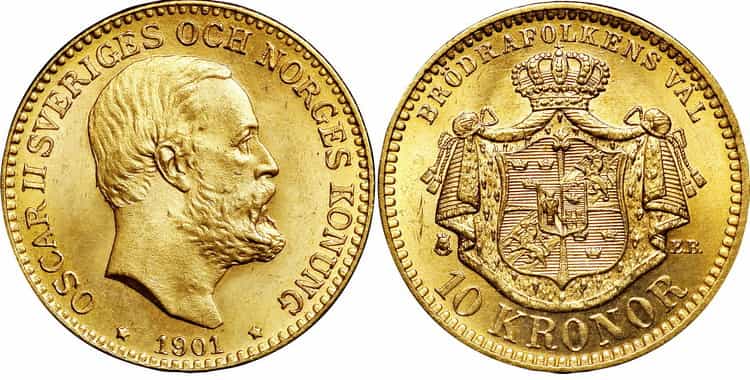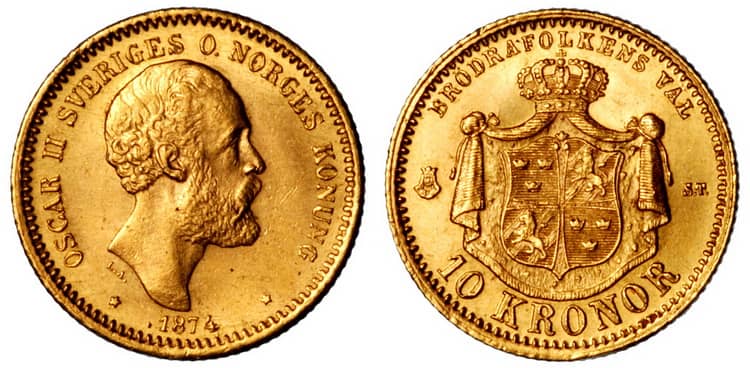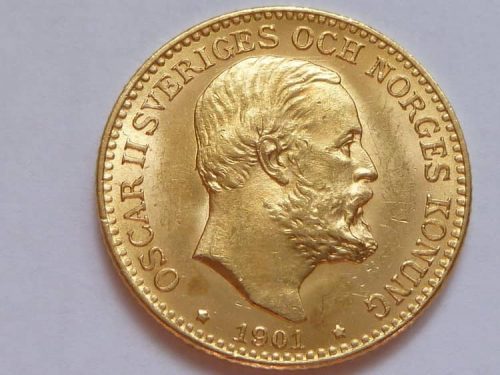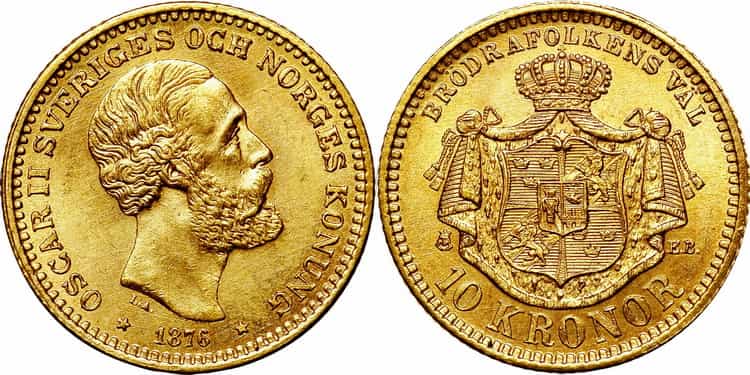
10 Swedish Kronor (1873-1901) is a gold coin that was in circulation in the territory of the Nordic countries (Denmark, Norway, Sweden). It was minted for a short time, but it had great historical significance, since it was associated with well-being and stability. The first edition was released after the appearance of the Scandinavian Monetary Union, and the last – before the World War I.
History
10 Swedish kronor of gold is the most popular coin in Scandinavian history. Before its appearance, a monetary union was concluded between the three countries – Sweden, Denmark and Norway. It assumed that all three states would have a single currency – the krona. It will be freely accepted as payment throughout Northern Europe. For this, it had to be equalized the value of each currency relative to the gold standard.

The main difficulty in combining the national currencies of the Scandinavian Monetary Union is a different system of measures, as well as a different metal content and size of coins. Swedish copies were minted in silver and yielded to the decimal system, while in Denmark and Norway calculation system was based on fractions. 1 krona was equal to 1/2 of the Danish riksmint or 1/4 of the Norwegian speciedaler or 1 Swedish riksdaler.
Did you know? Swedish coins, including 10 kronor of 1873-1901, are considered among the most beautiful coins in the world. In the opinion of many numismatic communities, the monetary unit is included in the world’s top ten ancient currencies, where there is a thoughtful design and many details that prevent counterfeiters from a chance for a successful fake. Currently, the security system on the kronor of Sweden is one of the best one in the world, so the purchase of kronor is as safe as possible.
Before the Swedish krona appeared, there was a currency of its own in Denmark, Norway and Sweden. On the Danish territory, riksmint was in circulation, on the Norwegian one – speciedaler, on the Swedish side – riksdaler. The former coins were minted from a cheap alloy, but after the adoption of the new monetary unit, all countries set up production from the precious metal. Later, when World War I began, gold was needed to pay for military operations, so gold coins were stopped to do, replacing them with nickel and silver.

Until 1873, the monetary system of the Scandinavian countries, like many others, was based on the silver standard. When, in 1871, England was one of the first to adopt the gold standard using the gold sovereign, Sweden and Denmark followed, and then Norway joined. Such a move was important because trade relations with Great Britain were established and brought significant income to all states.
Did you know? 1 Swedish krona was equal to 100 Øre – a bargaining chip of Sweden, Denmark and Norway. Such a system was used until 2010. The first era appeared on the Swedish territory in the 16th century under King Gustav I. The name comes from an ancient Roman coin aureus which translates as “gold”. Prices indicating the era can still be seen, but the amount is rounded up or down, and payment is accepted in crowns.
The first allied coins were 10 and 20 Swedish knonor (1873-1902). It goes without saying that anyone who had in their hands the old currency of one of the states, could freely exchange it in the bank for money made of gold. Old banknotes and coins of silver were exchanged at the Central Banks. The system based on the new currency has been debugged, therefore it has existed for almost 40 years. It turned out to be very simple, but effective, because it contributed to the development of trade and the prosperity of both Sweden and the allied countries.

The Scandinavian alliance achieved its main goal – a stable economy within the Nordic countries and the ability to pay with a new currency, regardless of location. The emergence of 10 Swedish kronor in 1873 helped to achieve market expansion, its unification between the countries concerned and the creation of a single monetary system. Therefore, it is with this coin that many associate stability, as well as the fact that it is easy to create monetary harmony between different countries.
Did you know? When the Swedish kronor came into use, it was tied to the gold standard. The cost of the coin was 1/2480 kilograms of pure gold. When the Scandinavian Monetary Union collapsed and the gold standard was abandoned, Sweden, Norway and Denmark retained the name of the currency (krona in Sweden, krone in two other countries). After joining the European Union, Denmark and Norway switched to the euro, and Sweden does not plan to accept this currency in the near future.
The Scandinavian Monetary Union officially collapsed in 1924, but lost its meaning much earlier. The World War I deprived the countries of Northern Europe of a calm existence and the opportunity to trade with payment by gold coins.
Design
It was originally planned that the appearance of 10 kronor would be the same for all the countries of Northern Europe, but only the weight, size, and also the standard remained standard. On the surface of the Swedish coin there is a portrait of the current ruler – King Oscar II (in the Danish copy Christian X, in Norwegian – Oscar II). The Swedish copy differs from the ones with the Norwegian Mintmark. The initials ST (Sebastian Tham) are engraved on a Swedish coin of 1875–1876, from 1876 and onwards EB (Emil Brusewitz).
Did you know? 10 Swedish kronor 1873-1901 designed by Lea Ahlborn, a Swedish artist who became the first female engraver appointed by the Royal Academy of Arts. She created stamps for many coins of Sweden and Norway, as well as medals with portraits of Swedish celebrities. She marked her works with an engraving of L. A.
Characteristics of 10 SEK (1873-1901)

Metal: gold.
Sample: 0,900.
Weight: 4.48 grams.
Denomination: 10 Kronor.
Diameter: 18 mm.
Quality: Regular release (UNC).
Obverse: Obverse: Oscar II’s portrait (face is turned to the right) is surrounded by an inscription. In the upper part of 10 Norwegian kronor is a semicircle with an inscription from left to right “OSCAR II NORGES o. SVER. KONGE ”(Oscar II, King of Norway and Sweden). The year is stamped at the bottom. The edge of the coin is decorated and has a small rim.
The reverse: In the center of 10 Sweden kronor is the national emblem is depicted – a shield crowned with a royal crown. Inside the shield are two crowned lions. On the right is the inscription SP (present exclusively on copies of the years 1874-1875). In the upper part of the semicircle there is an inscription * BRODERFOLKENES VEL * (Well-being of fraternal peoples), in the lower part there is the nominal value “10 KRONOR”.
Circulation
All gold and silver coins of Sweden are minted in Stockholm production until the Mint moved to Eskilstuna. Almost all samples can be seen brand name on the reverse on the left side in the form of the crowned head of the monarch.
10 Swiss kronor minted irregularly and in small quantities:
- 1873 – 200,000 pieces;
- 1874 – 461,058 pieces;
- 1876 – 133,000 pieces;
- 1877 – 55,023 pieces;
- 1880 – 26,553 pieces;
- 1883 – 148,917 pieces;
- 1894 – 36,020 pieces;
- 1895 – 65,352 pieces;
- 1901 – 213 286 pieces.
Cost of coins
The price of 10 SEK depends on the year of production and the degree of preservation. The cost of high quality coins reaches $ USD 250-300, and poorly preserved samples will cost $ USD 150-170.
Comments
No commens yet.